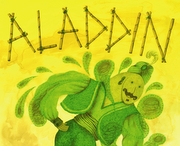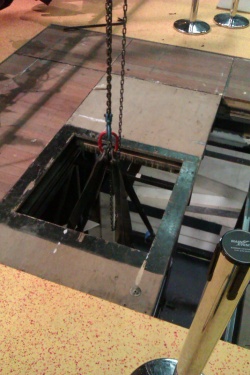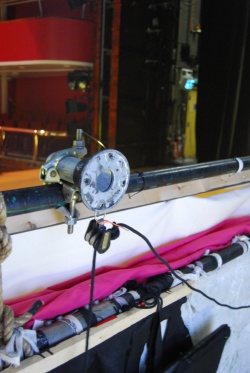Aladdin Panto 2011: Difference between revisions
| Line 150: | Line 150: | ||
===Kabuki Drop=== | ===Kabuki Drop=== | ||
===Glitter Drop=== | ===Glitter Drop=== | ||
[[image:Glitter Drop.JPG|250px]] | |||
===Trap Door=== | ===Trap Door=== | ||
Revision as of 02:00, 3 January 2012
| Aladdin Panto 2011 | ||||||||||||||||||
|---|---|---|---|---|---|---|---|---|---|---|---|---|---|---|---|---|---|---|

| ||||||||||||||||||
Aladdin
| ||||||||||||||||||
Cast
Abanazar - Chris Fulton (Max Greig)
Aladdin - Anthony Fagan
Dame - Mark Rowley
Emperor - Martin McBride
Empress - Natalie Songer
Genie - Brian(Christopher)Fisher
Narrator A - Ruby Richardson
Narrator B - Eve Ponsonby
Princess - Amiera Darwish
So Shy - Bobby Stewart
Wishee Washee - Ross Mann
Chorus - Sam Keefe, Cliodhna McCorley, Jimin Suh, Saria Steyl, Alasdair Hankinson, Molly Vevers, Lucy Hollis, Max Greig, Martin Mcbride
Crew
Production Manager - Sandy McRobbie
Stage Manager - Sarah Wilson
Deputy Stage Manager - Hannah Nicol
Assistant Stage Managers - Amber McClelland, Jack Hirst
Lighting Designer - Alexander Ridgers
Set Designer - Robin Peebles
Sound Designer - Jonathan Towers
Production Electrician - Fraser Walker
Deputy Production Electician - Melissa MacDonald
Technical Stage Manager - Fiona Nisbet
Deputy TSM - Rebecca Coull
Lighting Operator - Jade Beatson
Sound Operator - Jonathan Towers
LX Crew - Michael Parkin
Technical Crew - Neil Foulis, Graeme Brown, Kathryn Douglas, Ashley Kerray, Christopher McIntyre, Jane Paterson, Ben Terry, Natalie Wilson, Andrew McCabe
Set
The set for Aladdin consisted of large set pieces, a lot of flying pieces and cloths. The set was mainly flying pieces, with the peking palace scene required 8 bars for the one scene (not including the reveal gauze and black).
Cloths
Cloths that were used for a number of scenes and scene changes were the US cyc, the starcloth used as a full black (and as a starcloth), and a full black for the demon cave.
Four other cloths were used as part of the cave scene; three cut border cloths and one that had a lamp shape ccut out of it, for the actors to enter the cave.
Noodle Box
Demon Cave
Pyramid

The pyramid was the largest piece of set during the second act, taking up half of the scene dock. It had a solid wall with a door on one side, and the other three were gauze, with the US wall being in two pieces that could slide open. During the show, 3 crew members needed to push it, unseen, DS, and disappear down a trap behind it. Cast members and crew would then go up and down the trap on their cues, finally finishing with the baddie in the pyramid and having it spun by the cast to reveal him.
Technical Challenges
Genie Trap
The first thing that was done as part of the panto fit up was to lower the genie trap into place. The first that needed done was to find where the center point of the genie trap slider would be on stage, and make a bridal on the grid above this point. We made this using beam clamps and clutch chains. A shackle was then attached to the hook of the chain hoist and a rope dropped down to lift it up and attach to the point on the bridal.

Four slings were wrapped around the lid of the genie trap as this needed to be lifted on top of the genie trap mechanism and bolted on before it was lowered into the pit.

Once the lid was bolted on, ropes were attached to the genie trap to help guide it and the chain hoist (operated from the tallescope) was used to lift the genie trap off the ground slightly. On the first attempt at lowering it down, only one piece of staging was removed, which at the time seemed enough, but whilst lowering it we found that the trap had to be moved up and down stage to fit in; so the genie trap was lifted out again and another piece was taken out.

Just before getting it into its final position, packers needed placed between the beams in the stage and the trap to make it level with the stage. In the pit, a piece of 8by4 steel deck was placed underneath it with small screw jacks, to be able to change the height of the legs so the genie trap wasn't just floating in the pit.

Flying Carpet
The flying carpet mechanism was a collaboration between the production manager and the workshop tutors, who came up with something that had the 'magical' effect that the director was looking for.
 This is a basic model, that was made before the steel was bought, to make sure that the idea would work once built.
This is a basic model, that was made before the steel was bought, to make sure that the idea would work once built.
Kabuki Drop
Glitter Drop
Trap Door
About 5m US, a walk-down trap door was put in place to be used behind the pyramid. During the scene, various characters (and crew) use the trap to enter through the pyramid, and to exit through the pyramid and 'disappear'. The treads were originally made for Dracula, but can be used for any trap door position on the stage.





